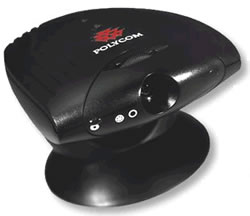Videoconferencing

Introduction
GridPP depends upon excellent communications between distributed
groups/individuals. We rely upon low-cost IP videoconferencing
facilities for operational discussions between multiple users at all
levels. We aim to monitor/comply with
evolving standards over JANET and
use IP videoconferencing and associated application sharing as a working
tool.
Industry standard for videoconferencing over IP is H.323. For
personal/desktop conferencing we use this both point-to-point and
multipoint. The latter requires the use of an MCU (Multipoint Control
Unit).
Note that e-Science uses AccessGrid, which uses a different
videoconferencing protocol.
Current Practice
(as of April 2003)
Users link into a video conference via their windows desktop using a
polyspan ViaVideo unit (earlier recommendation was using a Zydacron
card)
For point-to-point this allows application sharing (also known
as data collaboration capability) which works quite well.
For multipoint within GridPP in the UK we connect via gatekeeper
to an MCU (Multipoint Control Unit) maintained by
UCL media resources group, accessed via H.323 from individual
offices. Application sharing is possible, but current practice is to
rely upon pre-prepared web pages with links to all source material.
For International multi-point we link into
VRVS using H.323.
For multi-point within e-Science in the UK we use Access Grid
facilities which are available at each of the e-Science Centre
sites. Note that this is a different technology currently requiring
booking (and set-up) by your local e-Science centre. Beyond this there
are video-conference rooms at most Universities which can be booked
through your local Computing Service.
A review (and appendix) of
multi-site video-conferencing
requirements for the UK e-Science Programme provides more detailed
information.
Known Issues
Polyspan (and other vendors of hardware video codecs) support only
Windows and have no plans to support linux. Users of linux desktops -
see notes on Gnomemeeting below, but if a hardware codec is mandated then
you'd need access to a Windows PC (for the forseeable future).
A reliable backup/second MCU is required in cases where the UCL MCU
fails or is already booked.
Interworking between Access Grid and an individual polyspan
units require a validation process which has not really been tested.
Interworking between Access Grid and H.323 might be provided by
VRVS. This has has not really been tested.
Using a ViaVideo unit with VRVS requires an older version of
the software (version 2.2) to be installed.
Firewalls may restrict required ports. This may not be under your
control, but in general these have been overcome at all sites within the
UK (eventually).
MCU managers generally forbid use of software codecs such as
those in NetMeeting and GnomeMeeting.
Netmeeting should also not be used to connect into VRVS.
Solutions?
We track developments from
GnomeMeeting/OpenH323
(Please inform us if you are succesful with linux videoconferencing and
we will adopt working solutions here).
This is developing into a good software-codec solution on linux.
A volunteer site is needed which has sufficient resources to
maintain an additional MCU. This role is currently undertaken by Glasgow
(with limited resources).
Desktop systems with appropriate hardware can be registered
on JANET.
According to
http://www.jvcs.video.ja.net/docs/jvcsip.shtml
it appears that desktop systems can be registered for the JVCS (JANET
Videoconferencing Service IP): we are trying this now, watch this space
(or ask your local JVCS contact person).
If the ViaVideo doesn't appeal, there are comments on some other H.323
solutions at the VRVS pages
http://vrvs.org/Doc/Hardware/h323_clients.html
Contact
Any questions,
please contact Alan Flavell
